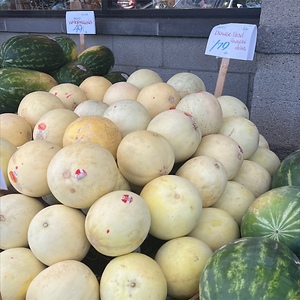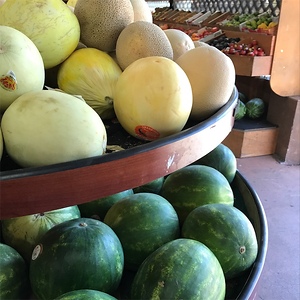


Orange-Fleshed Honeydew Melons
Estimated Inventory, 22 lbs : 0
Description/Taste
Orange-Fleshed honeydews are small to medium-sized melons, averaging 12 to 15 centimeters in diameter and 4 to 6 pounds in weight, and have an oval to round shape. The melon’s rind is smooth, thin, firm, and waxy, ranging in color from white to pale yellow, depending on maturity. The rind also develops a slightly sticky texture when ripe and is easily sliced when cut. The flesh is salmon-orange, thick, and dense beneath the surface with a crisp, semi-firm, juicy, and succulent consistency. There is also a small seed cavity in the center of the flesh containing light brown, oval seeds suspended in stringy white fibers. Orange-Fleshed honeydews emit a honeyed, musky aroma when ripe, feel heavy for their size, and the blossom end will give slightly under pressure. The flesh contains a refreshing, sweet, and subtly floral flavor.
Seasons/Availability
Orange-Fleshed honeydews are available in the summer through mid-fall.
Current Facts
Orange-Fleshed honeydews, botanically classified as Cucumis melo var. inodorus, are a hybrid muskmelon belonging to the Cucurbitaceae family. There are two main types of honeydew melons in commercial production, Orange-Fleshed honeydews, and green-fleshed honeydews. Orange-Fleshed honeydews are the rarer of the two, while green-fleshed honeydews are the most common in retail markets. Orange-Fleshed honeydews were created from a cross between a honeydew and muskmelon and were developed to showcase an aromatic flavor with a crisp texture, desired qualities from both parent varieties. The melons were also produced to have smooth skin, a trait beneficial in reducing unwanted pathogens such as salmonella on the surface. Pathogens are more likely to get caught on the exterior of textured, netted melons, increasing the chance of sickness if not properly cleaned. Despite Orange-Fleshed honeydews displaying quality characteristics generally preferred over traditional muskmelon and honeydew types, the melons have remained relatively unknown due to a lack of awareness among consumers.
Nutritional Value
Orange-Fleshed honeydews are a good source of beta-carotene, an orange-red pigment found in the flesh that is converted into vitamin A in the body. Vitamin A helps maintain healthy organ functioning, and the melons also contain vitamin C to strengthen the immune system, potassium to balance fluid levels within the body, fiber to regulate the digestive tract, and other amounts of vitamin K, calcium, copper, iron, magnesium, folate, and phosphorus.
Applications
Orange-Fleshed honeydews have a sweet, honeyed flavor well suited for fresh or lightly cooked preparations. Fresh Orange-Fleshed honeydews can be consumed straight, out of hand, halved and topped with yogurt, or sprinkled with citrus juice, salt, or ginger for added flavor. The melons can also be sliced and tossed into green salads, fruit salads, and grain bowls, cut and wrapped in cured meats, or blended and frozen into sorbet, popsicles, and granitas. In addition to culinary dishes, Orange-Fleshed honeydews are incorporated into smoothies, shakes, fruit punches, agua frescas, and cocktails. The melons can also be lightly grilled to develop a caramelized flavor or mixed into tarts and other dessert fillings. Orange-Fleshed honeydews pair well with fruits such as blueberries, strawberries, coconut, grapes, watermelon, and kiwi, tomatoes, cucumbers, mint, basil, balsamic vinegar, olive oil, and cheeses including goat, feta, and mozzarella. Whole, unwashed Orange-Fleshed honeydews will keep at room temperature for 5 to 7 days. Once cut, the melons should be stored in a sealed container in the refrigerator for 2 to 3 days.
Ethnic/Cultural Info
Orange-Fleshed honeydews are marketed under a variety of different names, such as Coup d' Orange, Orange Delight, Orange Blossom, Orange Bowl, Orange County, Orange Sherbet, and Orange Dew melons. The melons have also earned the name Temptation melon, given in reference to the honeydew’s sweet, irresistible nature. In the United States, Orange-Fleshed honeydews are mostly grown in California and are shipped nationwide as a specialty cultivar. The melons are known for having extended shipping and storage capabilities, allowing them to be easily transported to non-melon growing regions. In addition to the melon’s hardiness, scientists are studying Orange-Fleshed honeydews for their high beta-carotene content as food to reduce vitamin A deficiency.
Geography/History
Orange-Fleshed honeydews were developed from a cross of a common green honeydew with the tip top melon, a popular muskmelon in the 20th century. While the Orange-Fleshed honeydew’s exact history is unknown, one of the earliest documentations of the melon appeared in the Aggeler and Musser Seed Company catalog in 1929. Aggeler and Musser declared the melon to be a favored new type of honeydew in terms of color and flavor. Today Orange-Fleshed honeydews are still a rare, specialty variety that is challenging to find in commercial markets. The sweet melons are increasing in popularity worldwide as consumers expand their melon repertoires, but the honeydews are generally found through select grocers, distributors, and farmer’s markets. Orange-Fleshed honeydews are also cultivated in home gardens.
Recipe Ideas
Recipes that include Orange-Fleshed Honeydew Melons. One
| Seasoned to Taste |
|
Melon Agua Fresca |
| Nourished Kitchen |
|
Chilled Melon Soup |
| Angie's Recipes |
|
Orangedew Melon and Pomegranate Salad with Caper Berries |

















